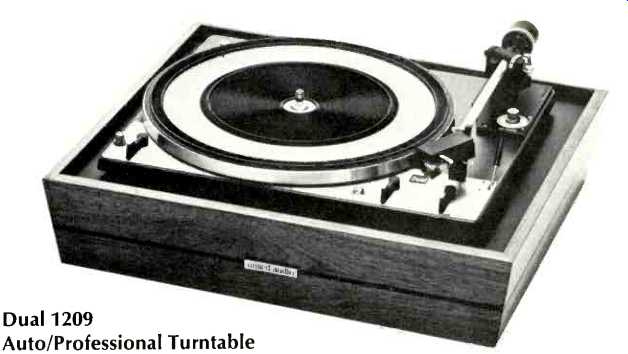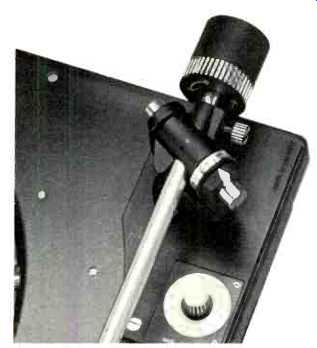
MANUFACTURER'S SPECIFICATIONS:
Speeds: 33 1/3, 45, 78 rpm.
Platter Diameter: 10 5/8 in.
Wow and Flutter (33 1/3 rpm): .08%. Max.
Tracking Error: 1.75 deg.
Arm Type: Balance & spring.
Arm Resonance: 8 to 14 Hz.
Change Cycle (33 1/3 rpm). 13 sec.
Clearance Below Motor Board: 2 3/4 in.
Clearance Above Board: 5 in.
Overall Dimensions: 13 x 10 3/4 in.
Weight: 10 lbs.
Price: $129.50.
Modern automatic turntables have almost replaced the earlier manual models, even in the installations of the more serious music lovers. Wow and flutter have been reduced, and the earlier bugaboo of the changer--rumble--has improved so much that there is no longer the great demand for the manual models, particularly since most of the automatics can be used manually just about as conveniently as the true manuals and still have some plus factors like automatic stop at end of play, automatic set-down on the first groove, and so on.
The Dual 1209 is not the top-of-the line product, but it is of similar construction to the top-the 1219. It is somewhat smaller, thus permitting its installation in less spacious surroundings, and what is more important to many users, it is considerably less expensive. Among its features are variable anti-skating, with Auto/Professional Turntable separate scales for conical and elliptical styli; counterweight arm balancing, with the weight flexibly mounted on the arm and adjusted coarsely by moving the rod on which it is mounted in and out to achieve an approximate balance, then turning it for a final fine adjustment.
Stylus force is then set by means of a calibrated dial on the arm mounting. The anti-skating adjustment knob is set to the same number as the stylus force dial, using the red scale for conical styli and the black scale for elliptical points. The unit is mounted in its base or on a motor board cut to the specified shape. Damped spring mounts with stamped metal cups fit into the precut holes. Clamping screws are provided to hold the chassis firmly against the base or motor board while it is being transported.
A lever at the right corner of the chassis selects the diameter at which the arm will set down--12, 10, or 7 in.--and another similar lever to the left of the first one is used to start or stop the playing.
When you move the lever to start, various bits and pieces in the unit are engaged to start the motor, raise the arm and move it to the proper set-down position, and then lower it to the record groove gently--all of this using power from the turntable platter itself. Move the lever to the stop position and the arm is raised from the record, moved to its rest, and lowered if there are no more records on the automatic spindle. If there are more, the arm again moves to the first groove and lowers. For those who do not want to use the changer function, there is a single-play spindle which fits into the turntable and rotates with it, thus eliminating wear on the record center hole from a stationary spindle. Just to the right of the arm rest is a cueing lever which raises or lowers the arm gently at the user's command. At the left front corner is the speed selector lever, similar in appearance to the other two levers. It is marked with the three nominal speeds--33, 45, and 78. Adjacent to this lever is the speed vernier which provides a ±3% speed variation for matching pitch precisely to a piano or other instrument--an important feature for musicians.
The platter is cast, and weighs 4 lbs., thus contributing substantially to the low wow-and-flutter figures of the machine.
It is driven by a rubber idler which is driven in turn by the three-stepped motor shaft, each step being slightly tapered to provide the vernier speed control. The platter is semi-permanently fixed to the bearing in the chassis, but can be removed when desired by using a small plastic cone device furnished. The "C" ring that holds the platter in place can be lifted out with the device, and easily put back in place by sliding the ring down the cone and into its locking groove.
The cartridge holder is a plastic molding which is locked in place by the arm lift which also serves as the releasing lever when it is moved backward. The holder permits moving the cartridge backward or forward to the prescribed location, as indicated by a small plastic jig which is slipped over the holder. One simply fastens the cartridge at the point where the stylus fits into a notch in the jig, which also shows the correct height of the stylus from the holder for the 15 deg. vertical tracking angle.
The motor is a high-torque synchronous design which gets the record up to the desired speed in less than half a revolution. Being synchronous, its speed is affected by variations in line frequency (of which there are few in this country) but voltage variations, of which there are likely to be many in any large city or at the end of a long rural transmission line have less than a ±1 per cent effect on speed over a range from 80 to 135 V. The idler, which transmits the rotating motion from the motor shaft to the rim of the platter, retracts when the unit is shut off, thus preventing the formation of flat spots.
Adjustments are provided for the exact set-down position to ensure that it is in the lead-in groove of the record, and also for the "cycling height" to ensure that the top of the tonearm should not touch the bottom record on a stack when using the automatic spindle. The output connections are made from phono jacks mounted on a bracket on the underside of the chassis. The a.c. connections also plug in, together with a ground lead, which should be attached to the system ground when the installation is first made.

Fig. 1--Showing arm balancing.
Performance
We made our tests on the 1209 with a B & O cartridge installed in the arm, and we found a wow and flutter measurement of .07% in the range from 6 to 250 Hz, but an increase to 0.13% in the range from 0.5 to 6 Hz, which also was reflected in the 0.5 to 250-Hz range. Since the range below 6 Hz would be inaudible anyhow, this could be a problem only with systems with the bass response extending down to d.c. and with speakers the likes of which do not exist. Arm resonance was found to be at 11 Hz with this particular cartridge, and the signal-to-noise ratio was 37 dB, referred to a stylus velocity of 3.54 cm/sec at 1000 Hz, which corresponds closely to the NAB specified level of 1.0 cm/sec at 100 Hz.
We have had experience with most of the Dual turntables over the past year, and we can say only that the 1209 carries out the tradition of its fellows. This model could easily be the second-choice selection by anyone who couldn't bring himself to disregard his budget. But it is unlikely that he would hear any difference between the 1209 and its more costly big brother, the 1219. There may be some other reasons why the 1219 is more costly, but for the average listener, the 1209 would certainly provide excellent record playing along with convenience.
-C.G. McP.
(Audio magazine, Oct. 1970)
Also see:
Dual Model 1218 Automatic Turntable (Equip. Profile, Jan. 1972)
Dual Model 1249 Automatic Turntable (Equip. Profile, Feb. 1977)
Dual 1249 turntable (ad, Jan. 1976)
Dual 601 Turntable (Jan. 1976)
Dual CS 731Q Automatic Single-Play Turntable (May 1980)
Dual CS 5000 Turntable and Ortofon X3-MC Cartridge (Nov. 1988)
= = = =